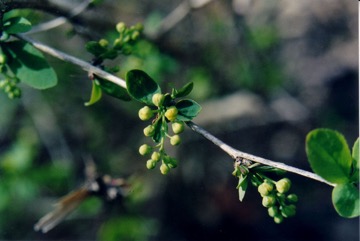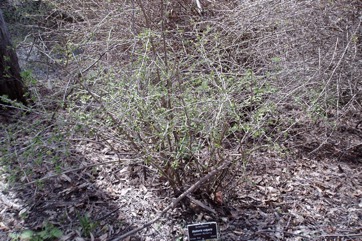Common Barberry, European barberry

It grows in temperate places. It can grow in full sun or light shade. It is not tolerant of salt spray. They will grow in a range of soils. They are cold hardy. It suits hardiness zones 3-9.
Also known as:
Agracejo, Barbariss, Barberi eropa, Barberi kuning, Berberry, Chatroa, Dracila, Fajisoska, Holy thorn, Jaundice berry, Kashmol, Kisel tran, K’otsakhuri, Kukerpuu, Murtillo, Navadni češmin, Nyulsom, Paaburitsud, Paburits, Paburitskad, Pipperidge bush, Piprage, Simsirika, Soska, Soskaborloya, Zareshk, Zutika
Edible Portion
- Fruit, Herb, Spice, Leaves
Where does Common Barberry grow?
Found in: Afghanistan, Africa, Albania, Asia, Australia, Austria, Azerbaijan, Balkans, Belarus, Belgium, Bosnia, Britain, Bulgaria, Canada, Caucasus, Czech Republic, Estonia, Europe, France, Georgia, Germany, Greece, Hungary, India, Indonesia, Italy, Lithuania, Luxembourg, Macedonia, Mediterranean, Moldova, Netherlands, North Africa, North America, Poland, Portugal, Romania, Russia, SE Asia, Slovakia, Slovenia, Spain, Switzerland, Tasmania, Tajikistan, Turkey, Ukraine, United States, Yugoslavia
Notes: There are about 450-500 Berberis species. It is an alternate host for wheat rust.
Growing Common Barberry, European barberry
Cultivation: It can be grown from fresh seed. Stored seed probably need cold stratification for 2-3 months before sowing. Plants can be grown from semi-ripe cuttings with a heel. Suckers can be removed and planted. Young stems can be encouraged to root by layering
Edible Uses: CAUTION: Plants in this group are slightly poisonous. The fruit are tart but rich in Vitamin C and used for jelly, jam and sweets. Also for drinks. They are also dried. The young leaves are eaten raw in salads or as seasoning for meats. The fruit are used to flavour rice dishes in Afghan cooking.
Production: Dried ripe barberries are about 10 mm long.
Nutrition Info
per 100g edible portion| Edible Part | Energy (kcal) | Protein (g) | Iron (mg) | Vitamin A (ug) | Vitamin c (mg) | Zinc (mg) | % Water |
|---|---|---|---|---|---|---|---|
| Fruit dried | 294 | 4.5 | - | - | - | - | 14.5 |
| Leaves | - | - | - | - | - | - |
Common Barberry, European barberry Photos


References
Abbet, C., et al, 2014, Ethnobotanical survey on wild alpine food plants in Lower and Central Valais (Switzerland). Journal of Ethnopharmacology 151 (2014) 624–634
Bircher, A. G. & Bircher, W. H., 2000, Encyclopedia of Fruit Trees and Edible Flowering Plants in Egypt and the Subtropics. AUC Press. p 58
Bodkin, F., 1991, Encyclopedia Botanica. Cornstalk publishing, p 142
Bremness, L., 1994, Herbs. Collins Eyewitness Handbooks. Harper Collins. p 94
Brown, D., 2002, The Royal Horticultural Society encyclopedia of Herbs and their uses. DK Books. p 142
Bussman, R. W., et al, 2016, A comparative ethnobotany of Khevsureti, Samtskhe-Javakheti, Tusheti, Svaneti, and Racha-Lechkhumi, Republic of Georgia (Sakartvelo), Caucasus. Journal of Ethnobiology and Ethnomedicine (2016) 12:4
Bussman, R. W. et al, 2017, Ethnobotany of Samtskhe-Javakheti, Sakartvelo (Republic of Georgia), Caucasus. Indian Journal of Traditional Knowledge Vol. 16(1) pp 7-24
Cakir, E. A., 2017, Traditional knowledge of wild edible plants of Iğdır Province (East Anatolia, Turkey). Acta Soc Bot Pol. 2017;86(4):3568.
Christanell, A., et al, 2010, The Cultural Significance of Wild Gathered Plant Species in Kartitsch (Eastern Tyrol, Austria) and the Influence of Socioeconomic Changes on Local Gathering Practices. Chapter 3 in Ethnobotany in the New Europe. Berghahn Books.
Ciocarlan, N. & Ghendov, V., 2015, Ethnobotanical and Ecological Studies of Wild Edible Plants from Bugeac Steppe, Republic of Moldova. Journal of EcoAgriTourism. Cailta terra Vol. 11(2):
Cundall, P., (ed.), 2004, Gardening Australia: flora: the gardener's bible. ABC Books. p 231
Denes, A., et al, 2012, Wild plants used for food by Hungarian ethnic groups living in the Carpathian Basin. Acta Societatis Botanicorum Poloniae 81 (4): 381-396
Elias, T.S. & Dykeman P.A., 1990, Edible Wild Plants. A North American Field guide. Sterling, New York p 219
Ertug, F, Yenen Bitkiler. Resimli Türkiye Florası -I- Flora of Turkey - Ethnobotany supplement
Esperanca, M. J., 1988. Surviving in the wild. A glance at the wild plants and their uses. Vol. 1. p 74
Etherington, K., & Imwold, D., (Eds), 2001, Botanica's Trees & Shrubs. The illustrated A-Z of over 8500 trees and shrubs. Random House, Australia. p 127
Facciola, S., 1998, Cornucopia 2: a Source Book of Edible Plants. Kampong Publications, p 48
Flowerdew, B., 2000, Complete Fruit Book. Kyle Cathie Ltd., London. p 168
Food Composition Tables for the Near East. http://www/fao.org/docrep No. 532
Glowinski, L., 1999, The Complete Book of Fruit Growing in Australia. Lothian. p 179
Harris, E & J., 1983, Field Guide to the Trees and Shrubs of Britain. Reader's Digest. p 55
Hedrick, U.P., 1919, (Ed.), Sturtevant's edible plants of the world. p 99
Hemphill, I, 2002, Spice Notes. Macmillan. p 59
Irving, M., 2009, The Forager Handbook, A Guide to the Edible Plants of Britain. Ebury Press p 49
Kremer, B.P., 1995, Shrubs in the Wild and in Gardens. Barrons. p 139
Kybal, J., 1980, Herbs and Spices, A Hamlyn Colour Guide, Hamlyn Sydney p 54
John, L., & Stevenson, V., 1979, The Complete Book of Fruit. Angus & Robertson p 74
Lord, E.E., & Willis, J.H., 1999, Shrubs and Trees for Australian gardens. Lothian. p 207
Łukasz Łuczaj and Wojciech M Szymański, 2007, Wild vascular plants gathered for consumption in the Polish countryside: a review. J Ethnobiol Ethnomedicine. 3: 17
Luczaj, L., 2012, Ethnobotanical review of wild edible plants of Slovakia. Acta Societatis Botanicorum Poloniae 81(4):245-255
Lukasz, L., et al, 2013, Wild edible plants of Belarus: from Rostafiński’s questionnaire of 1883 to the present. Journal of Ethnobiology and Ethnomedicine 2013, 9:21
Lukasz, L., 2016, Wild Edible Plants Traditionally Used in Poland.
Lyle, S., 2006, Discovering fruit and nuts. Land Links. p 87
Macmillan, H.F. (Revised Barlow, H.S., et al) 1991, Tropical Planting and Gardening. Sixth edition. Malayan Nature Society. Kuala Lumpur. p 312
Mabey, R., 1973, Food for Free. A Guide to the edible wild plants of Britain, Collins. p 161
MacKinnon, A., et al, 2009, Edible & Medicinal Plants of Canada. Lone Pine. p 98
Medsger, O. P., 1939, Edible Wild Plants. Macmillan Company. p 11
Nedelcheva A., 2013, An ethnobotanical study of wild edible plants in Bulgaria. EurAsian Journal of BioSciences 7, 77-94
Pieroni, A. & Soukand, R., 2018, Forest as Stronghold of Local Ecological Practice: Currently Used Wild Food Plants in Polesia, Northern Ukraine. Economic Botany, XX(X) pp. 1-21
Plants for a Future database, The Field, Penpol, Lostwithiel, Cornwall, PL22 0NG, UK. http://www.scs.leeds.ac.uk/pfaf/
Redzic, S. J., 2006, Wild Edible Plants and their Traditional Use in the Human Nutrition in Bosnia-Herzegovina. Ecology of Food and Nutrition, 45:189-232
Saunders, C.F., 1948, Edible and Useful Wild Plants. Dover. New York. p 97
Sfikas, G., 1984, Trees and shrubs of Greece. Efstathiadis Group. Athens. p 56
Simkova, K. et al, 2014, Ethnobotanical review of wild edible plants used in the Czech Republic. Journal of Applied Botany and Food Quality 88, 49-67
Singh, H.B., Arora R.K.,1978, Wild edible Plants of India. Indian Council of Agricultural Research, New Delhi. p 50
Soukand, R. & Kalle, R., 2016, Perceiving the Biodiversity of Food at Chest-height: use of the Fleshy Fruits of Wild Trees and Shrubs in Saaremaa, Estonia. Hum Ecol 44:265–272
Sp. pl. 1:330. 1753 (type species)
Sukarya, D. G., (Ed.) 2013, 3,500 Plant Species of the Botanic Gardens of Indonesia. LIPI p 592
Tardio, J., et al, 2006, Ethnobotanical review of wild edible plants in Spain. Botanical J. Linnean Soc. 152, 27-71
Wilson, S., 1997, Some Plants are Poisonous. Reed. p 31
World Checklist of Useful Plant Species 2020. Royal Botanic Gardens, Kew